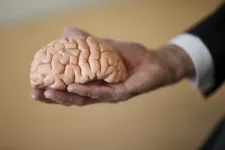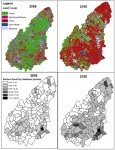Research pinpoints the time of year and hour when people have the strongest suicidal thoughts
2023-05-12
(Press-News.org)
New research has identified the month when people have the strongest suicidal thoughts, and that these thoughts occur a few months before the peak of suicide behaviours in spring/early summer. It also showed the daily peak in suicidal thought is between 4-5 am.
Most people assume suicide rates will be highest in winter, yet spring/early summer is when suicidal behaviours peak and this finding has baffled researchers since first identified.
Research from the University of Nottingham’s School of Psychology, led in collaboration with the University of Amsterdam and Harvard University, has study has examined the seasonal paths of suicidal thoughts and identified when suicidal thoughts peak during the year and also what time of day these thoughts are the worst. The findings have been published in Nature Translational Psychiatry.
Over a period of six years, responses were collected from over 10,000 people in the UK, US and Canada who completed questionnaires and tasks about their moods and thoughts and ideations around suicide and self-harm using the Project Implicit Health Database (PIH).
The researchers, Brian O’Shea and René Freichel, show that suicidal thoughts are, in fact, highest in winter (December), and they developed a conceptual model for why suicidal behaviour takes a few months to reach a ‘tipping point’. They also found that the hours of 4am-6am are when people are likely the most vulnerable to taking their own lives. Additionally, they found a general increase in negative self-harm cognitions across the six-year period of the study.
Dr Brian O’Shea from the University of Nottingham led the study and explains: “It is well documented that winter is the time when people with mental health problems may struggle with worsening mood and depression, indeed Seasonal Affective Disorder is a recognised issue related to the change in season that affects many people’s mental health. So, it may come as a surprise that spring, a time when you would assume people’s mood lifts, is actually the time of year when people are most at risk of taking their own lives. The reasons for this are complex, but our research shows that suicidal thoughts and mood are the worst in December and the best in June. Between these two points, there is a heightened risk of suicidal behaviour, and we feel this is occurring because the gradual improvements in their mood and energy may enable them to plan and engage in a suicide attempt. The relative comparison between the self and others’ mood improving at a perceived greater rate are complementary possibilities that need further testing.”
Online tasks were created to examine the temporal dynamics of explicit and implicit self-harm cognitions, with explicit cognition examined via direct questions about mood, suicide and self-harm using a standard 1-5 scale. Implicit cognition was explored with a reaction time task where people were required to sort words relating to the self in real-time with death and life words.
The respondents in the sample were from three groups: (1) past suicide attempters; (2) suicide ideation and/or non-suicidal self-injury; (3) no previous self-harm, suicidal thoughts, or behaviours). The researchers found a general increase of negative self-harm cognitions across the six years and seasonality effects for mood and desire to die, particularly among those who previously made a suicide attempt.
The findings show a latency between the peak of explicit and implicit suicide cognition in winter and the peak in suicide attempts and suicide deaths in spring. Explicit suicide cognition which peaks in December preceded implicit self-harm associations, which peaks in February. Both these peaks precede the peak of suicide behaviour in spring/early summer. Similar lagged effects were observed in a 24-hour period, with explicit suicidal cognition and mood peaking at 4-5 am and implicit cognition lagging this peak.
Dr O’Shea adds: “This study is the first to look at temporal trends around mood and self-harm thoughts on such a large scale and really pinpoints times when intervention could be most beneficial.”
END
ELSE PRESS RELEASES FROM THIS DATE:
2023-05-12
Using artificial intelligence (AI) to process natural language, a research group evaluated the characteristics of speech among patients with Parkinson’s disease (PD). AI analysis of their data determined that these patients spoke using more verbs and fewer nouns and fillers. The study was led by Professor Masahisa Katsuno and Dr. Katsunori Yokoi, Nagoya University Graduate School of Medicine, in collaboration with Aichi Prefectural University and Toyohashi University of Technology. They published their results ...
2023-05-12
A team of astronomers led by the University of Southampton have uncovered the largest cosmic explosion ever witnessed.
The explosion is more than ten times brighter than any known supernova (exploding star) and three times brighter than the brightest tidal disruption event, where a star falls into a supermassive black hole.
The explosion, known as AT2021lwx, has currently lasted over three years, compared to most supernovae which are only visibly bright for a few months. It took place nearly 8 billion light years away, when the universe was around 6 billion years old, and is still being detected by a network of telescopes.
The researchers believe that the explosion is ...
2023-05-12
A previously unrecognised sedimentary archive in sand dunes could unlock a repository of fire records, a discovery that could expand fire histories across the globe.
The research, conducted by Dr Nicholas Patton during his PhD at The University of Queensland, has solved a persistent problem facing historians investigating changing fire patterns.
“Knowing how the frequency and intensity of wildfires has changed over time offers scientists a glimpse into Earth’s past landscapes, as well as an understanding of future climate change impacts,” Dr Patton said.
“To reconstruct fire records, researchers usually rely heavily ...
2023-05-11
Could changing your diet play a role in slowing or even preventing the development of dementia? We’re one step closer to finding out, thanks to a new UNLV study that bolsters the long-suspected link between gut health and Alzheimer’s disease.
The analysis — led by a team of researchers with the Nevada Institute of Personalized Medicine (NIPM) at UNLV and published this spring in the Nature journal Scientific Reports — examined data from dozens of past studies into the belly-brain connection. The results? There’s a strong link between particular kinds of gut bacteria and Alzheimer’s disease.
Between 500 and 1,000 species of bacteria ...
2023-05-11
AMHERST, Mass. – Researchers at the University of Massachusetts Amherst recently published a study in the journal PLOS Water that focuses on the Sudbury-Assabet and Concord watershed in eastern Massachusetts, and which links hydrological changes, including floods, drought and runoff, to changing patterns of land use.
“We all live in a watershed” says Timothy Randhir, professor of environmental conservation at UMass Amherst and the paper’s senior author. “We’re constantly modifying our landscape, turning what were once forests into ...
2023-05-11
Irvine, Calif., May 11, 2023 – Researchers from the University of California, Irvine have found that exposure to traffic-related air pollution in Irvine led to memory loss and cognitive decline and triggered neurological pathways associated with the onset of Alzheimer’s disease.
“The link between air pollution and Alzheimer’s disease is concerning, as the prevalence of toxicants in ambient air is not just on the rise globally, but also hitting close to home here in Irvine,” said corresponding ...
2023-05-11
Across the United States, legislators and the public have debated the issue of bail reform, which aims to reduce pretrial jail populations by eliminating cash bail. New York State passed legislation in 2019 to limit the use of money bail and expand pretrial release. In a new study, researchers evaluated the effect of the law on state crime rates, considering the effect of the COVID-19 pandemic. Although rates of murder, larceny, and motor vehicle theft rose after the bail reform law went into effect, none of the increases were statistically significant when compared with a control group. This suggests that the effect of bail reform on crime rate increases was negligible.
The study, ...
2023-05-11
Sometimes life’s most meaningful relationships grow from the briefest of connections. Like when you go to a party and meet someone wearing your favorite band’s T-shirt, or who laughs at the same jokes as you, or who grabs that unpopular snack you alone (or so you thought) love. One small, shared interest sparks a conversation—that’s my favorite, too!—and blossoms into lasting affection.
This is called the similarity-attraction effect: we generally like people who are like us. Now, new findings from a Boston ...
2023-05-11
About The Study: Lecanemab and associated ancillary services could add an estimated $2 billion to $5 billion annually to Medicare spending with substantial out-of-pocket costs for beneficiaries lacking supplemental coverage, according to a cost analysis using nationally representative survey data. Lecanemab, an antidementia medication with modest clinical benefit, received accelerated Food and Drug Administration approval.
Authors: John N. Mafi, M.D., M.P.H., of the David Geffen School of Medicine at the University of California, Los Angeles, is the corresponding ...
2023-05-11
LEXINGTON, Ky. (May 11, 2023) — The University of Kentucky, as lead organization, together with partners across Kentucky and Tennessee, has been awarded $1 million from the U.S. National Science Foundation’s Regional Innovation Engines, or NSF Engines, program. This team’s proposal, “Advancing carbon centric circular economy technologies for advanced manufacturing solutions (KY, TN),” is led by a coalition named Generate Advanced Manufacturing Excellence for Change (GAME Change).
The GAME Change team is among the more than 40 unique teams to receive one of the first-ever NSF Engines ...
LAST 30 PRESS RELEASES:
[Press-News.org] Research pinpoints the time of year and hour when people have the strongest suicidal thoughts






